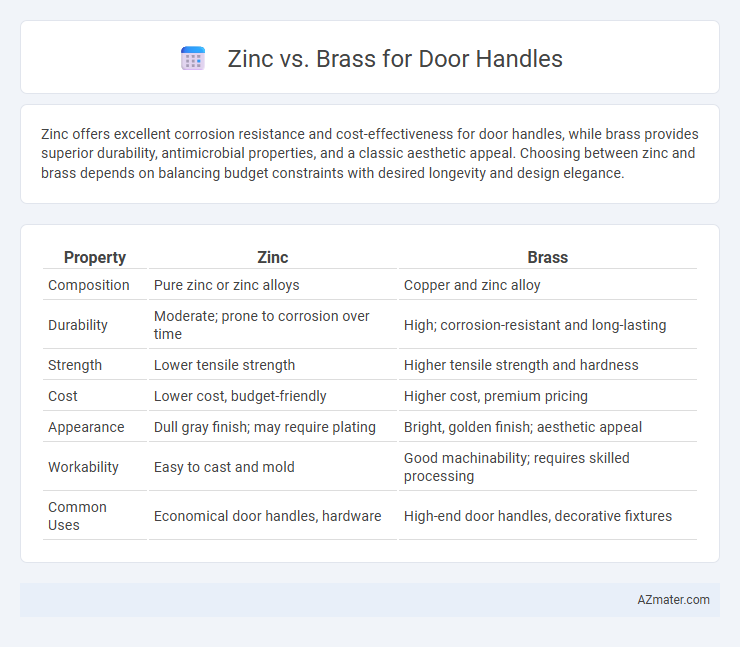Zinc offers excellent corrosion resistance and cost-effectiveness for door handles, while brass provides superior durability, antimicrobial properties, and a classic aesthetic appeal. Choosing between zinc and brass depends on balancing budget constraints with desired longevity and design elegance.
Table of Comparison
| Property | Zinc | Brass |
|---|---|---|
| Composition | Pure zinc or zinc alloys | Copper and zinc alloy |
| Durability | Moderate; prone to corrosion over time | High; corrosion-resistant and long-lasting |
| Strength | Lower tensile strength | Higher tensile strength and hardness |
| Cost | Lower cost, budget-friendly | Higher cost, premium pricing |
| Appearance | Dull gray finish; may require plating | Bright, golden finish; aesthetic appeal |
| Workability | Easy to cast and mold | Good machinability; requires skilled processing |
| Common Uses | Economical door handles, hardware | High-end door handles, decorative fixtures |
Introduction to Zinc and Brass Door Handles
Zinc door handles offer excellent corrosion resistance and affordability, making them a popular choice for both residential and commercial applications. Brass door handles, composed primarily of copper and zinc, provide superior durability and a timeless aesthetic with natural antimicrobial properties. Both materials allow for versatile design options and reliable performance, but brass typically excels in longevity and classic appeal.
Material Composition: Zinc vs Brass
Zinc door handles are primarily composed of zinc alloy, which includes additives like aluminum, copper, and magnesium to enhance durability and corrosion resistance. Brass door handles consist mainly of copper and zinc, with varying copper content affecting color, strength, and malleability, offering superior corrosion resistance and a classic aesthetic. The choice between zinc and brass depends on the balance between cost-effectiveness, mechanical strength, and environmental resistance required for the door handle application.
Aesthetic Appeal and Finish Options
Zinc door handles offer a modern, sleek aesthetic with a smooth surface ideal for high-definition finishes such as chrome plating and brushed nickel, enhancing contemporary interior designs. Brass handles provide a classic, warm look with natural golden hues that develop a unique patina over time, contributing to a vintage or traditional ambiance. Both materials support a variety of finishes, but zinc excels in diverse color treatments while brass remains preferred for its rich, timeless appearance and durability.
Durability and Longevity Comparison
Zinc door handles offer limited durability due to their susceptibility to corrosion and wear over time, making them less ideal for high-traffic areas. Brass door handles provide superior longevity with excellent resistance to rust, scratches, and tarnishing, thanks to their copper-zinc alloy composition. The robust nature of brass ensures consistent performance and aesthetic appeal over years of frequent use.
Corrosion and Rust Resistance
Zinc offers excellent corrosion and rust resistance due to its natural protective oxide layer, making it ideal for door handles exposed to moisture or outdoor environments. Brass, an alloy of copper and zinc, also provides strong corrosion resistance, especially against tarnishing and rust, but it can develop a green patina over time with prolonged exposure to air and moisture. Both materials are durable, but zinc excels in maintaining a rust-free surface without requiring frequent maintenance compared to brass.
Security and Strength Performance
Zinc door handles provide excellent corrosion resistance and moderate strength, making them suitable for residential use with enhanced durability. Brass door handles offer superior strength and enhanced security due to their robustness and resistance to impact, often preferred for commercial or high-traffic applications. The choice between zinc and brass hinges on required security performance, with brass generally outperforming zinc in terms of long-term structural integrity and resistance to forced entry.
Cost Analysis: Zinc vs Brass Handles
Zinc door handles generally offer a more cost-effective solution compared to brass handles, with prices often 30-50% lower due to the abundance and lower processing costs of zinc alloys. Brass handles, made from copper and zinc, provide superior durability and corrosion resistance but come at a premium price influenced by fluctuating copper market rates. For budget-conscious projects, zinc handles deliver acceptable performance and aesthetic appeal, while brass remains the preferred choice for long-term investment in high-end applications.
Environmental Impact and Sustainability
Zinc door handles offer a lower environmental impact due to the metal's high recyclability and abundant natural reserves, reducing the need for mining and lowering carbon emissions. Brass, an alloy of copper and zinc, typically has a higher ecological footprint because copper mining is more energy-intensive and less sustainable. Both materials can be recycled, but zinc's recycling process is more energy-efficient, making it a preferable choice for eco-conscious building projects.
Maintenance Requirements
Zinc door handles require minimal maintenance due to their corrosion resistance and ability to retain finish without frequent polishing. Brass handles, while aesthetically pleasing with a natural patina over time, need regular cleaning and occasional polishing to prevent tarnishing and maintain shine. Choosing zinc reduces upkeep efforts significantly compared to brass, especially in high-traffic or outdoor environments.
Choosing the Best Material for Your Door Handle
Zinc door handles offer excellent corrosion resistance and affordability, making them ideal for indoor use where budget is a priority. Brass handles provide superior durability, antimicrobial properties, and an elegant, timeless appearance, often preferred for high-traffic or exterior doors. Selecting between zinc and brass depends on factors like desired aesthetics, environmental exposure, and maintenance requirements to ensure longevity and performance.

Infographic: Zinc vs Brass for Door Handle
 azmater.com
azmater.com